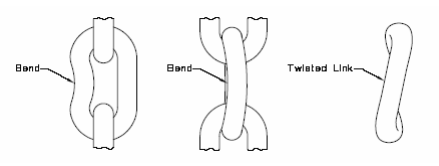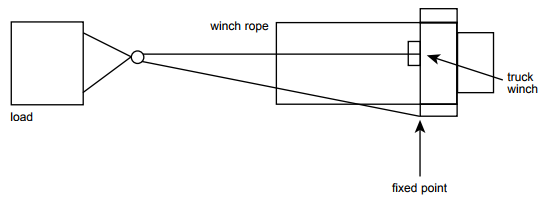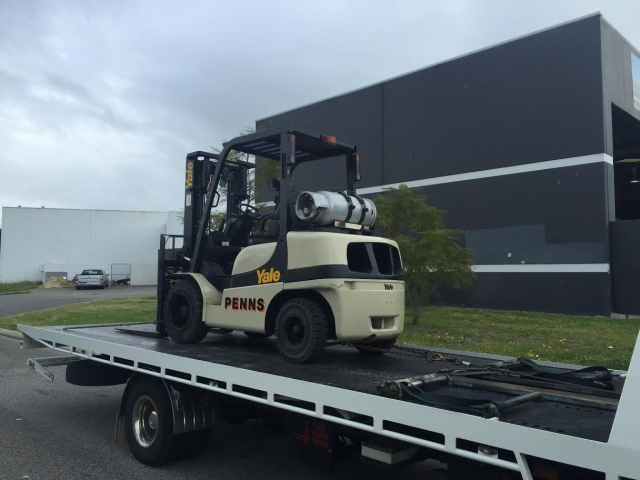When operating tilt tray vehicles, safety is the top priority, and this guide takes you through best practice for loading and unloading vehicles. A tilt tray vehicle is one where the rear can be lowered, with a winch used to load it up. This can include wheeled or self-propelled equipment, skid mounted equipment, site sheds and sea containers.
Who’s Responsible For Health And Safety?
Everyone on-site has a duty of care and is responsible in their own part for health and safety. Both employers and employees should play their part by ensuring they know the proper procedures, and report any potential hazards on-site. Proper training, instruction, and supervision needs to be given to those working with tilt tray tow trucks at all times, ensuring that safe procedures are always followed, without cutting corners.
If you have on-site contractors, then they must also follow health and safety guidelines, and should be briefed when they begin work. This will ensure they know proper procedures and can play their part in safety. Whether workers are employed or contractors, they are still responsible for health and safety, and will need to co-operate with H&S representatives.
Further information can be found in guidance note ‘General duty of care in Western Australian workplaces’ from the Department of Commerce.

Personal Protective Equipment (PPE)
An important part of health and safety is using personal protective equipment (PPE) on site. When using a tilt truck, the operator should use:
- Safety shoes
- A hi-vis vest
And if required:
- Eye and/or ear protection
- Gloves
- Sun protection
When carrying out a risk assessment, consider which articles of safety clothing will be needed.
Road markings such as marker cones or witches hat are also important, as they can be used when working on or near the road. These markers should be kept in the vehicle, so they’re available whenever space needs to be made to load or unload.
Training
Training is an important part of health and safety, and needs to be provided to anyone operating a tilt truck, as well as supervisors and offsiders. Training should involve modules including assessing a job, inspecting and selecting equipment, attachment methods, how to use a winch and how to secure the load, and needs to cover:
- How to recognise the characteristics of a load, whether wheeled or non-wheeled
- Site hazards and security
- Working on or adjacent to roads
- Working on sites without adequate lighting
- Creating a safe work zone when loading or unloading
- Working safely on busy work sites
- Working in difficult weather conditions
- Soft, uneven or sloping ground
- How to choose the correct load attachment points
- Selecting the correct slings or attachments, and how different configurations can affect the load bearing capacity
- Precautions that need to be taken if attachments can’t support the full pull of the winch
- How slings will have a reduced load limit if two of them are used at an induced angle
- Use of specialist slings for particular pieces of equipment
- Inspecting the winch rope and hook and recognising defects
- Ensuring a clear path when winching the load onto the tilt tray
- How to secure a load to the winch rope
- Selecting and securing a tow point
- Hold down equipment strength
- Calculating the load exertion on equipment
- Selecting hold down equipment
Inspecting Equipment
Each time equipment is used, it’s important that the operator carries out an inspection. Learning to inspect equipment should be a key part of training for any operator or anyone involved in the process of using a tilt tray.
While the equipment should be checked on use, regular maintenance checks should also be carried out by a qualified, experienced person who is able to detect faults with slings, lifting attachments, chains and any other items used in the process.
In addition to being able to identify any visual faults with the equipment, the operator should also be able to:
- Work out the safest anchor points on the load
- Safely use every piece of attachment equipment that is carried in their truck
- Check that the correct attachments and slings have been provided in their truck
- Dispose of damaged equipment so it’s not accidentally used by another operator
Winch and winch ropes
Winch attachments need to be inspected regularly, and if any looseness or damage is identified, they should be handed over for repair or disposal. Also, look out for damage to the winch rope and winch hook attachment. Any visible damage should be checked by a competent person who can decide whether it’s OK to use.
Hooks
Check that the mouth of the hook isn’t opened out, and that the hook has a safety catch. Inspect visually for any damage, and pass to a competent person if there are any doubts.
Chain and chain slings


Look for damages such as bent or twisted links, as per the above illustrations. Check for signs of wear, such as entrance wear to the bearing surface as shown. If any links are showing signs of elongation, discard the whole sling.
Wire rope slings
Carry out a visual inspection, and if any damage is spotted to the eye fixings or wire rope, pass to a competent person for further inspection.
Chain grabs or shorteners
Chain grabs should be the correct size for the chain being used, and if any damage is spotted, it’ll need to be inspected. Chain shorteners can be used to reduce chain length, and should also be inspected for damage, as well as ensuring that the configuration of the load limit is down-rated appropriately when these attachments are used.
Web belts
When using web belts, inspect them for visible damage or cuts to the webbing or deteriorated stitching. If any are spotted, refer to a competent person before continuing with usage.
Load Attachment Equipment
Selecting attachment equipment
To ensure the safe working load limit of an item isn’t exceed by the force by the winch, the correct attachment equipment must be selected. This can include hooks, slings, winch ropes and fittings.
Adjusting the hydraulic system is a simple way to limit the maximum force exerted by the winch. Hydraulic system adjustments are usually carried out by a competent person. The force exerted by the winch needs to be below the working load limit of any attachment device that attaches the load to the winch. This is because:
- It’s difficult for operators to see how much force is being put on the equipment by visual interpretation alone.
- If there’s an obstruction, force exerted on the winch increases, quickly exceeding load limits for attachments, without much warning or time to shut down the equipment.
- The weakest point between the load attachment and winch drum can fail if working load limits are exceeded. This can cause the load to fail, causing injuries or fatal accidents.
It’s not always practical to provide attachment equipment that can withstand the pull of a hydraulic winch, which can sometimes reach over 15 tonnes. The pull of the winch should therefore be limited to the specific amount needed for the heaviest load.
Snatch blocks

The above diagram shows how a snatch block is used. When a snatch block is used, with a winch rope around the pulley and hook attached to a fixed point, then the winch pull is almost doubled. Therefore, any attachments, slings or other equipment need to have an appropriate working load limit.
Draw bars for sea containers
To load or unload a sea container in a controlled manner, a draw bar can be attached instead of chain slings. Helping to prevent the misuse of chains or other attachments, draw bars can be used when slings aren’t suitable as they’d need an excessive angle.
Ejector devices for sea containers
Equipment can be fitted to eject a sea container from a tilt tray using hydraulic rams. This equipment can be retrofitted to many types of trucks. It’s important to follow manufacturer’s instructions when using this equipment.
Operation Method
Whether it’s wheeled or non-wheeled equipment, the usual way to load a tilt tray is to get the truck into a position close to the load, then tilt the tray down to ground level.
Using a sling or similar attachment, a winch rope is attached and the hydraulic controls allow the operator to load the truck.
When loading a tilt tray, it’s important to consider the hazards to yourself, employees, and the people around you. That’s why training is such an important part of the process, ensuring operators are able to spot any potential issues with equipment, maintenance needs, or adjustments that need to be made for weather conditions, unusual loads and other eventualities. With proper training, operators can keep themselves and those around them safe.
Hydraulic Winches
Hydraulic winches pull loads onto the tilt tray, and therefore are an important part of the loading process. That’s why they need regular inspections and maintenance from a competent person, and records should be kept when these are carried out.
The winch is attached to the truck with bolts. Consult the manufacturer’s instructions for proper usage and location of bolts.
Any attachments to the winch rope, and the winch rope hook, should be attached according to manufacturer’s instructions too. Winch ropes should ideally be fitted with safety latches and a swivel hook.
If a rope becomes tangled on the drum, and a load is added, winch ropes can be easily damaged. There are devices available that prevent tangling of the rope, and they can be retrofitted to a variety of winches. Get in touch with your winch manufacturer to find out more.
Winch operation
To ensure the operator carried out the loading procedure as approved, ongoing supervision should be provided. It’s important that the operator doesn’t change procedures to opt for less safe but easier procedure.
Winch control location and operator position
When installing or relocating controls, some positions are safer than others, and it’s important to choose the safest position. Unfortunately, should there be an attachment breakage, there is no position that’s considered safe for the operator, which is why a strict system of training and inspection of the winching train (including the winch rope, sling, attachments etc.) is carried out to prevent breaking.
Winches are often fitted with remote controls, and operators sometimes carry the remote, moving to a position close to the chain slings and winch rope. In these situations, the operator is putting themselves at a higher risk, so should be discouraged.
Load Restraint
Load restraint is an important part of using a tilt tray, as it keeps the load in place during transportation. Chains can be used to secure an ISO container, but with a large number required, it’s often recommended to install twist locks in the bed of the truck instead. Wheel mounted loads, skid mounted containers and other equipment should be secured as below.
ISO containers
There should be written procedures in place that detail the method for securing a load. Each vehicle should have a copy of the procedures, and operators should receive training. Because ISO containers are problematic when it comes to load restraint, it’s important to follow The Load Restraint Guide.
Container restraint without the use of twistlocks
As per the Load Restraint Guide, a load must be able to withstand the forces below, without shifting:
- 0.8 x weight of load when moving in a forward direction
- 0.5 x weight of load behind and to either side
- 0.2 x weight of load moving upwards
If twistlocks aren’t being used for restraint, then loads must be supported on a rubber load mat, timber dunnage, or both. If a system is being used without any of the above, then it must be engineer certified, to ensure it meets guidelines.
Tie-down and stops
Tie-down relies on friction to restrain a load, and because steel and steel has low-friction, this method isn’t suitable use alone. If the container is being transported without twistlocks, then there needs to be suitable stops applied to each side of the load, and the container restrained vertically, ensuring it cannot move over the stops. This needs to be done in accordance with the guide.
Example: a load with a mass of eight tonnes, with stops on each side which withstand the specified horizontal load, would also need a vertical tie-down which could withstand 0.2 x W or 1600 kgf. 1500 kgf of restraint is provided by an 8mm chain with over-centre dog for tension, and so to remain compliant with the Guide, two chains would need to be used for vertical restraint.
Tie-down only
Using tie-down methods only on a steel deck is not an acceptable practice. As mentioned before, the low friction between steel and steel means that in dry conditions, you’d need 22 chains to meet the compliance standards set by the Guide.
If conditions are wet, a very low amount of friction will be created, and so it’s unlikely that tie-down methods alone would make the load compliant.
Cross chaining
Cross chaining can be used for lateral or longitudinal restraint, and with this method the lashings create the restraining force, rather than friction.
Take the example above of the load with a mass of eight tonnes. Using a chain at both sides and each end, each with a minimum capacity of 3.8 tonnes and tensioned appropriately with a turnbuckle, this load could be restrained using the cross chaining method.
Restraining the container in the example fully would require eight chains and turbuckles, which requires time for fitting and tensions, and means operators would have to work at a height to attach them to the upper corners. If the commercial vehicle didn’t have lashing rails with a suitable load capacity, then additional lugs would also have to be fitted.
Using loading equipment for restraint
Loading equipment such as winches should only be used for restraint when it’s certified for that purpose, and used as per instructions.
See Also
The Load Restraint Guide – Transport Commission and National Road & Traffic Authority
Occupational Safety and Health Regulations 1996
Australian Standard AS 3775.2 – 2014 Chain slings for lifting purposes – Grade T(80) and V(100) Part 2: Care and use
